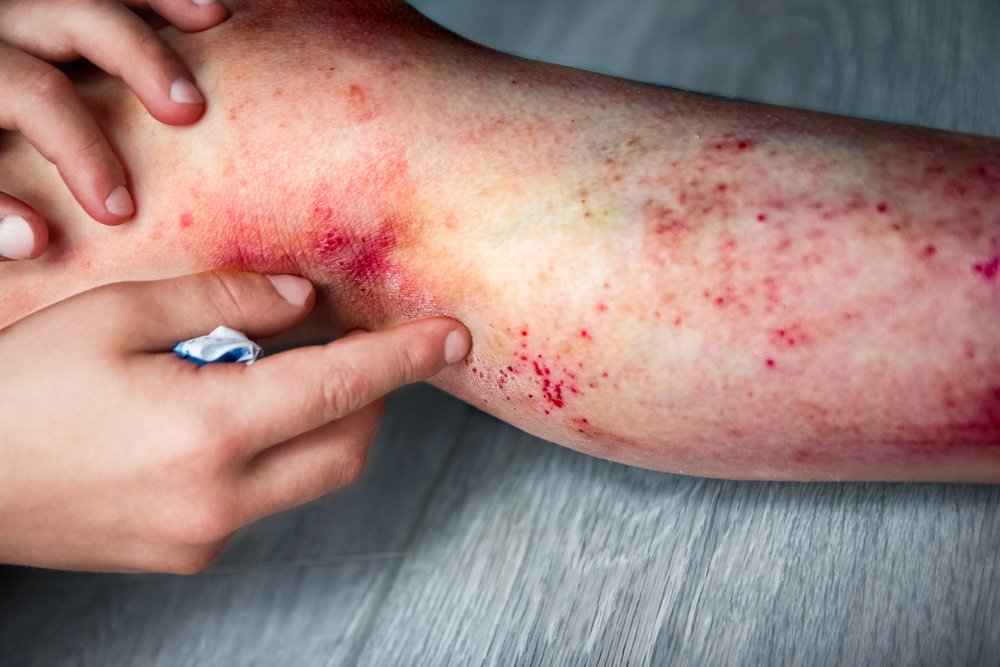Learn
Delve into dermatology diseases with new approaches from conventional to complementary care.
Topics
Explore a broad spectrum of dermatological conditions and topics to enhance your practice.
Training Programs
Expert led instruction for every level of patient care.
Log in to see enrolled program content.
Conferences
Gain practical insights and meet new colleagues.
Hover over a conference to view recordings.
Join Us
The largest integrative dermatology community.
Eyelid Dermatitis (Eczema) Causes & Treatments
Common culprits of itchy irritated eyelids

Eyelid eczema, also called eyelid dermatitis, is an inflammatory reaction involving the skin on the eyelid. This can be chronic or seasonal and may affect one or both eyes. Sometimes only the eyelids are affected, but it can also spread to surrounding areas. Eyelid eczema is commonly related to atopic dermatitis (commonly known as eczema) and can be caused by an allergic reaction (allergic contact dermatitis) or exposure to an irritant (irritant contact dermatitis). No matter the cause, the result is itchy, red, and uncomfortable eyelids.
How Common Is Eyelid Eczema?
There are many different conditions that can manifest on the eyelids. These include irritant contact dermatitis, allergic dermatitis, rosacea, seborrheic dermatitis, psoriasis, and infections, among others. The most frequent cause of an eyelid related skin condition is in response to an allergic reaction, affecting up to 77% of the population followed by irritant contact dermatitis.[1] Many studies have consistently demonstrated that there is a female predominance in the development of eyelid eczema.[1,2] This gender disparity raises questions for the underlying cause, such as the use of cosmetics in developing eyelid dermatitis.
Most Sensitive Skin
The skin on the eyelids is the thinnest skin on the body, at a thickness of 0.5mm as compared to other parts of the body at 2.0 mm.[1] This delicate layer of skin also contains many blood vessels and very little fat. As a result, the eyelids are one of the most sensitive areas of the body, making them susceptible to penetration of irritants and airborne allergens. The tendency of the eyes to be frequently touched and their site of common cosmetic use puts them at a higher risk of developing an eczematous reaction. In fact, it is not uncommon for an allergen or irritant to come into contact with the body at a site other than the eyelids and cause a reaction on the eyelids alone.[1]
Common Culprits
The causes of eyelid eczema can be traced to many different sources. These reactions can either be caused as a result of an allergic reaction or due to an irritation. Irritants are ingredients that cause a reaction on your skin after contact but do not trigger an immune reaction like an allergen would. However, they both can cause similar adverse skin reactions. The type of reaction that occurs (irritant versus allergic) is dependent on the individual. Contact or transfer of irritants or allergens to the eyelids from the scalp, hands, face and even airborne particles, are enough to cause an eczematous reaction.
Nails
People subconsciously touch their eyes many times throughout the day, and a surprisingly common cause of eyelid eczema can be from the use of nail products like nail polish and artificial nails. The main ingredients responsible are methacrylates, cyanoacrylates, and tosylamide formaldehyde resin.[3,4] These chemicals are used in the bonding of artificial nails, and as a varnish to help adhere polish to the nail. The resins used during the bonding process to form the acrylic nail can become airborne and irritate the eyes. However, often times, eyelid eczema result from simply rubbing or touching the eyes with fake or polished nails, even if a reaction on the nails or fingers are not present.[2]
Makeup and cosmetics
Makeup contains many different chemical compounds that can initiate an allergic or irritant reaction of the eyelids. Common sources of eyelid eczema from cosmetics include:
- Mascara
- Eyeliner
- Eyeshadow
- Eye pencils
- Makeup brushes
- Eyelash curler
The use of makeup brushes and applicators can provoke an eczema flare. The bristles of the brushes can be made of synthetic materials or animal fur that can initiate an irritant or allergic reaction.
Sometimes, an allergy to a metal is the cause of eyelid eczema. Cosmetics containing pigment will commonly contain the metals nickel, cobalt, chromium and lead. Nickel is the most common metal cause and is commonly found in mascara, eyeshadow, eyebrow pencils, and even eyelash curlers.[3,5,6] Accidental transfer from hands that have touched nickel can also cause a reaction.[6]
Chemical exposure
Exposure to various chemicals is another cause of eyelid eczema. Chemical compounds are found in many typical everyday products such as cleaners, air fresheners, laundry products, perfumes, skin care products, and more. The majority of products used daily contain chemicals that can cause an allergic or irritant reaction on the skin. Many of these chemicals can be airborne, meaning that the product doesn’t need to be directly applied to the eyelid to cause a reaction. Due to the thin sensitive skin overlying the eye, these airborne molecules are able to easily pass through the top layer of skin and cause a rash. Other potential triggers can be hidden within skin care or beauty products, and even in eye drops. Some of the most common chemical exposures that lead to eyelid eczema include:
- Fragrance[1]
- Chlorine[7]
- Soap
- Preservatives[1]
- Cosmetics
- Hair dye[8]
- Eye drops and contact solutions[1]
- Topical antibiotics[1]
What Can You Do?
Eyelid eczema can be successfully treated. Determining what is causing the reaction will help reduce the chances of having the eyelid rash come back. There are many irritants and allergens in the environment which can make it difficult to exactly pinpoint the root cause. A simple way to help determine the cause of flares is to keep a diary of when the reaction occurs and what the possible trigger was. This can help to rule in and rule out common culprits. Sometimes cosmetics that you have been using for years can still be a possible culprit.
Applying a protective barrier around the eyes can be a strategy when concerned about chemical exposures. One effective topical barrier is petroleum jelly. Not only does it act as a protective barrier but it also serves as a moisturizer by trapping the natural moisture of the skin.[9]
If the cause of eyelid eczema is suspected as a result of using cosmetics, the best way to prove this would be to stop using the offending products. If the reaction persists, a consultation with a dermatologist is recommended and dermatologists may be able to help you decide what tests or treatments may be helpful and may include the use of skin allergy testing.
References
- Amin KA, Belsito DV. The aetiology of eyelid dermatitis: a 10-year retrospective analysis. Contact Dermatitis.2006;55(5):280-285; PMID: 17026693 Link to research.
- Wolf R, Orion E, Tuzun Y. Periorbital (eyelid) dermatides. Clin Dermatol.2014;32(1):131-140; PMID: 24314387 Link to research.
- Guin JD. Eyelid dermatitis: experience in 203 cases. J Am Acad Dermatol.2002;47(5):755-765; PMID: 12399770 Link to research.
- Jacob SE, Stechschulte SA. Tosylamide/formaldehyde resin allergy--a consideration in the atopic toddler. Contact Dermatitis.2008;58(5):312-313; PMID: 18416766 Link to research.
- Karlberg AT, Liden C, Ehrin E. Colophony in mascara as a cause of eyelid dermatitis. Chemical analyses and patch testing. Acta Derm Venereol.1991;71(5):445-447; PMID: 1684478 Link to research.
- Landeck L, John SM, Geier J. Periorbital dermatitis in 4779 patients - patch test results during a 10-year period. Contact Dermatitis.2014;70(4):205-212; PMID: 24325408 Link to research.
- Seki T, Morimatsu S, Nagahori H, et al. Free residual chlorine in bathing water reduces the water-holding capacity of the stratum corneum in atopic skin. J Dermatol.2003;30(3):196-202; PMID: 12692355 Link to research.
- Gupta M, Mahajan VK, Mehta KS, et al. Hair dye dermatitis and p-phenylenediamine contact sensitivity: A preliminary report. Indian Dermatol Online J.2015;6(4):241-246; PMID: 26225326 Link to research.
- Sethi A, Kaur T, Malhotra SK, et al. Moisturizers: The Slippery Road. Indian J Dermatol.2016;61(3):279-287; PMID: 27293248 Link to research.
Related Articles

Atopic Dermatitis
Atopic Dermatitis Case Discussion with Dr. Peter Lio

Atopic Dermatitis
Navigating the Complexities of Atopic Dermatitis and Prurigo Nodularis: A Clinical Toolkit for Practitioners

Atopic Dermatitis
Navigating Atopic Dermatitis and Hand & Foot Dermatitis




